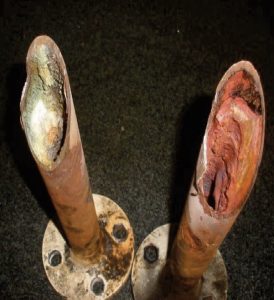The Charity
Aviation
Maritime
Exhaust Gas Heater Fire Suppression System – Large Ferry

Initial Report
What did the reporters tell us?
In the course of work to fit exhaust gas scrubbers in a large ferry, pipes serving the exhaust gas heater fire suppressant system had to be cut; pipes/nozzles were found to be nearly blocked and thinned. This would have prevented the system from working as designed in event of fire. The cause was probably leakage past isolation valves allowing seawater to enter the ‘supply lines’. Salt then crystallized in the heat. The comprehensive report outlines remedial action. Extracts from the information passed to CHIRP. ‘Given the condition of the pipes and nozzles – had we had a fire in the exhaust gas heaters, it would have been very unlikely that the fire suppression system would have had any effect. The reason for the blocking of the nozzles is that it is suspected that the isolating valves on the fire main have been leaking past, allowing sea water to fill the supply lines and when reaching the hot environs of the exhaust gas heaters, the water has rapidly evaporated, leaving a build up of hard salts in the nozzles. We are proposing some modifications to the fire suppression system: The nozzles and pipe-work will be like for like, but with a different routing to allow easier access for inspection in the future. Pipes and nozzles will be galvanised. New valves will be fitted to the fire main at the branch off of the supply lines. The original valves are ‘globe’ valves, we intend to change these for stainless steel ball valves. Immediately after the isolating ball valves, we will fit stub pipes with a further ball valve fitted on each line. This valve will serve two purposes:
(1) to check for any water leaking past the isolating valves and
(2) to connect an air hose and blow air up through the supply lines and nozzles to prove clear. This will be put into the Planned Maintenance System as a routine (probably monthly) job. These ball valves will have plugs fitted in the outlets at all times when not in use. The valves will be fitted with clear signage as to their purpose’.

Heavily obstructed pipes – Ferry Fire Suppression System
The lessons to be learnt
This comprehensive report detailed how a fault, which could have had serious consequences, was discovered in the course of routine work. It then laid out the actions which were taken to rectify the fault (by the replacement of piping), and the measures instituted to ensure regular testing in both company ships fitted with the system. A natural question surrounds the symptoms which might indicate such a problem in the making. For an emergency system, this may well be difficult. However it is crucial that all emergency systems have stringent inspection/test regimes, preferably controlled within the ships Planned Maintenance System, to ensure successful operation if required. The inspection/test regime may identify design shortfalls, as experienced in the report, which will initiate corrective action involving redesign, material selection, avoidance of water traps (u-bends) and improved testing techniques.
CHIRP Suggests
Take note of this case. Check similar installations in other ships, and ensure that regular and reliable inspections are followed. Watch for ‘out of sight, out of mind’. Emergency gear of all kinds, including firefighting gear, is not in regular use; defects may therefore go unnoticed. And yet – when these equipments are needed – they are needed immediately and in full working order to save life. Invest in their maintenance.







